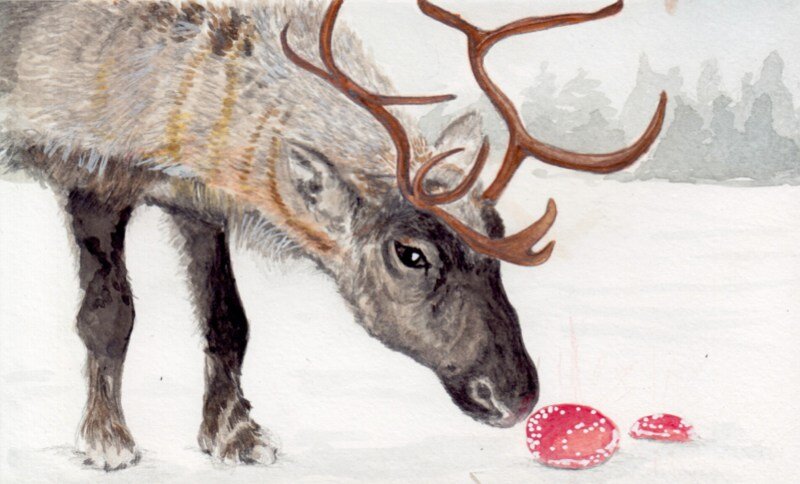The Ancient Origins of Christmas
As we approach the end of the year, I invite you into deep remembrance of how potent and sacred this time of year truly is. There are many ideas of what this time of year stands for in different cultures and areas of the world.
Largely, this time relates to witnessing the dark, shadowy parts of life and within ourselves – and in turn, celebrating the return of the sun as the days begin to get longer.
Yule is a celebration of Pagan tradition, occurring each year on the winter solstice – the longest night of the year. This occurs because the northern hemisphere is tilting away from the sun.
Many of the traditions typical of Christmas-time overlap with the traditions of Yule. This is because the birth of Christmas as a holiday originates from the ancient Rome celebration of Saturnalia – the pagan celebration of Saturn for a bountiful season of agriculture.
The people of Rome celebrated for an entire week, closing businesses to feast and celebrate. They would decorate their homes with wreaths and other greenery, shed their traditional clothing for more colorful options, and would spend the week singing, dancing, gifting, and feasting.
A common gift was a candle, which was intended to celebrate the return of the waxing sun. When Rome began converting to Christianity, it was easy for the civilization to simply rebrand it into a Christian holiday.
In many cultures, the evergreen tree is a representation of everlasting life and is regarded as a protection from harm. In the times of ancient Rome, on the eve of winter solstice a priest would cut down, decorate, and bring an evergreen into temple celebrations.
Pagan families brought evergreen trees into their home as a symbol of the spring soon to come, bringing the return of other plants and greenery. In fact, the tradition of having Christmas trees was regarded in America as strange and socially not acceptable up until the mid-1800s because it was associated with Paganism.
In old Norse tradition, Yule is a celebration to thank the gods for the return of the sun. Wreaths were hung throughout people’s houses as a reminder that spring was to come now that the sun was returning. Mistletoe was hung and was thought to be a protection, as well as a powerful healing agent. In place of a tree, the tradition was to burn a Yule Log from an oak tree as an additional form of protection. The tradition of using holly was believed to repel unwanted spirits.
Shamanic Origin of Christmas
Another important recollection of the winter solstice celebration is the shamanic origin of Christmas. This is a beautiful story originating from the indigenous people of Siberia, located very close to the north pole of the earth. Reindeer roam the lands here and the tribes depended upon the domestication of the reindeer for many things – including clothing, tools, transportation, etc.
These incredible creatures are a beautiful expression of femininity, as they are the only female member of the deer family that possesses antlers – and they keep their antlers during all seasons while the males shed theirs.
Reindeer herds were also led by the female elders in the group, rather than the males. Consistent with this, the Siberian shamans of this time were also female.
Image source: weightlessky.com
A large part of the shamanic journey in this part of the world consisted of the use of the red and white mushroom: Amanita Muscaria. This psychedelic mushroom requires that it be dried out to reduce toxins, so the shamans would often hang the mushrooms in the branches of the evergreen trees they grew beneath – creating a familiar scene of evergreens being decorated with bulbs of red + white. When the mushrooms were dry, the shaman would then begin to fill up a sack to bring back to the village – sound familiar? The mushroom often creates hallucinations of flying, which could explain the vision of Santa flying with reindeer and a sack of gifts.
Image source: inhabitat.com
In addition, reindeer were often seen eating the mushrooms... therefore creating the symbolism of the "flying reindeer." Sometimes, Siberians would even drink the urine of the reindeer for its hallucinogenic properties.
These shamans wore cloaks of red with white fur to honor the medicine of the mushroom. When she was done with her journey, the shaman would then visit the villagers to bring the gifts of knowledge and wisdom received from the mushrooms. Because the village was covered in snow, the homes were often snowed in and the shaman would sometimes come through the top of the home where the smoke exited.
Image source: Medium.com
If we think about the nature of the winter solstice, the absence of the sun (the masculine pole) during this darkest night of the year leads us into a very feminine presence. While we are celebrating the return of the light, we are also being asked to sit with the darkest parts of ourselves – learning from the past year and altering our course for the future depends on our findings. The moon is the more present celestial body during this time of year, which represents our emotions, shadow, and creativity.
How can you create an intentional space to celebrate and reflect this year?
Build an altar. You can include things that resonate with you, such as candles, pine, mistletoe, holly, etc.
Light candles, and celebrate the return of the light!
Learn about how your culture celebrates this time of year. What were the customs of your ancestors? How did they celebrate?
Set aside time to reflect – what has the journey of this year taught you, and where do you want to take it moving forward?
I hope that whichever ways you decide to celebrate the return of the sun bring you joy and cheer this year!





